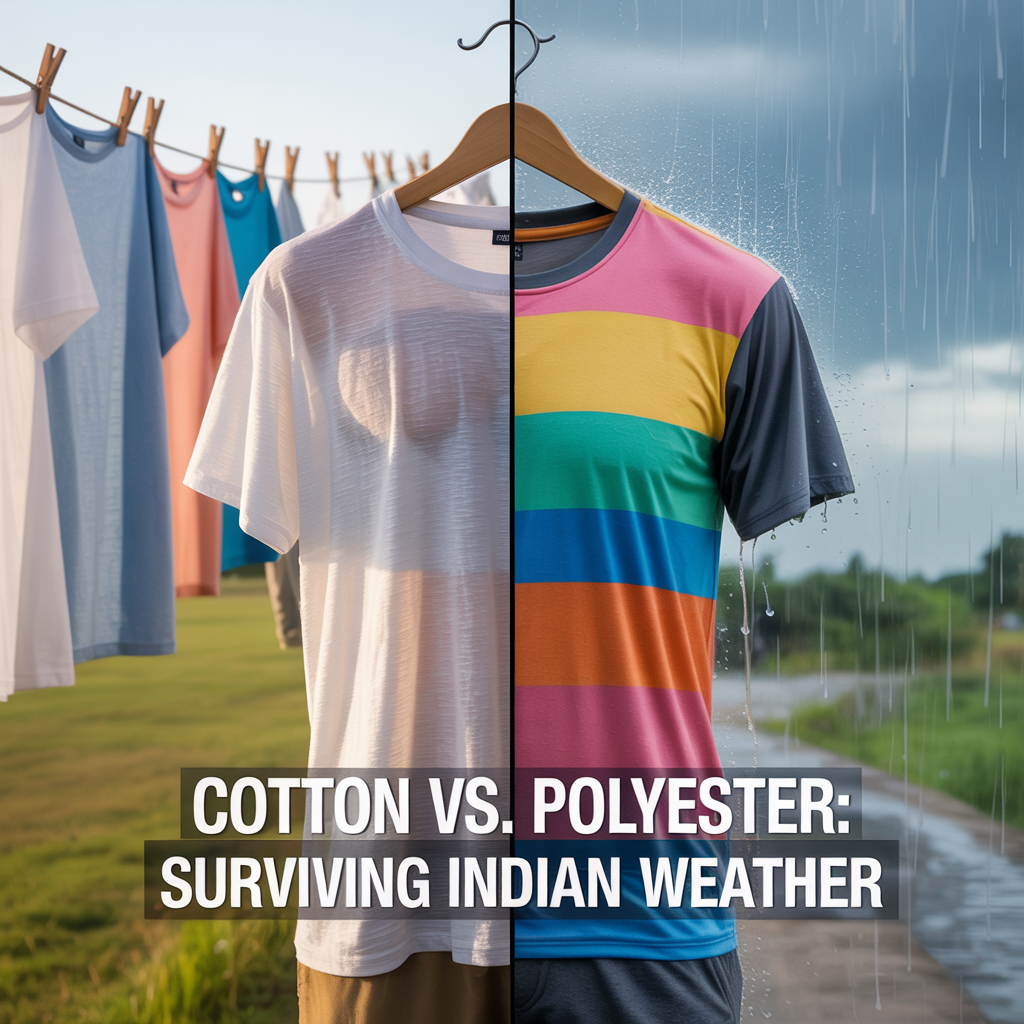“Cotton vs. Polyester T-Shirts: Which Fabric Is Better for Indian Weather?”

Ever stood in front of your closet on a sweltering summer day, questioning your life choices as you debate between the cotton tee that might show sweat stains or the polyester one that feels like wearing a plastic bag? You're not alone.
I'm about to settle the cotton vs. polyester debate specifically for Indian weather conditions, where temperatures can make choosing the wrong fabric feel like a personal betrayal.
The truth is, picking between cotton and polyester t-shirts for Indian weather isn't just about comfort—it's about surviving our unique climate while still looking put-together.
What if I told you one fabric clearly outperforms the other across most Indian regions, but there are specific situations where the underdog is actually the smarter choice?
Understanding Indian Weather Patterns

Extreme Heat and Humidity Challenges
Ever tried wearing a polyester shirt during peak summer in Delhi? It's like wrapping yourself in plastic wrap while standing in a sauna. Indian summers are brutal - with temperatures soaring above 40°C in many regions and humidity levels that make you feel like you're swimming through air.
This extreme heat-humidity combo creates a perfect storm for discomfort. Your body needs to breathe, and your clothes play a huge role in whether you're miserable or managing. When sweat can't evaporate quickly enough, you're left with that sticky, clingy feeling that makes everything worse.
Seasonal Variations Across Regions
India isn't just one climate - it's dozens packed into one country. What works in Rajasthan won't cut it in Kerala.
The north experiences dramatic temperature swings - scorching summers and chilly winters. Meanwhile, coastal regions maintain high humidity year-round but with more moderate temperatures. The hills? That's another story altogether with cool temperatures that rarely demand summer-specific fabrics.
This climate diversity means most Indians need a versatile wardrobe that can handle:
-
Dry heat (North Indian summers)
-
Wet heat (Coastal regions)
-
Cold dry conditions (Northern winters)
-
Cool humid weather (Hill stations)
Monsoon Impacts on Clothing Choices
Monsoon season throws another wrench into the fabric equation. When it rains for days on end, drying becomes a major concern.
Picture this: you get caught in a downpour on your way to work. Now you're stuck in soggy clothes all day. How quickly they dry and how comfortable they feel when wet suddenly matters a lot more than how they looked when dry.
During monsoons, your clothing needs to:
-
Dry quickly after getting wet
-
Resist developing musty odors
-
Not become completely see-through when soaked
-
Maintain shape after repeated wetting and drying
Urban vs. Rural Climate Differences
The concrete jungle creates its own weather patterns. Cities are heat islands - typically 3-5°C warmer than surrounding rural areas. This urban heat effect means city dwellers face even more extreme conditions than their rural counterparts.
Urban commuters have unique challenges too. Jumping between air-conditioned metros and sweltering streets creates temperature shocks your clothing needs to handle. Meanwhile, rural settings might offer more natural ventilation but come with higher exposure to direct sunlight and dust.
Your clothing needs differ dramatically based on whether you're:
-
Commuting in crowded city transport
-
Working in air-conditioned offices
-
Spending time outdoors in rural settings
-
Moving between multiple environments daily
Cotton T-Shirts: The Traditional Choice

Natural Breathability Benefits
Ever worn a cotton t-shirt on a sweltering summer day in Delhi? That sweet relief isn't just in your head. Cotton fabric has thousands of tiny air pockets that allow your skin to breathe. Unlike synthetic materials that trap heat, cotton creates a natural ventilation system right against your skin.
Most Indians gravitate toward cotton tees during summer months because they don't feel suffocating. The natural fibers create pathways for air circulation, preventing that sticky, sweaty feeling we all hate when temperatures climb above 35°C.
Moisture Absorption Properties
Cotton drinks up sweat like nothing else. A good quality cotton t-shirt can absorb up to 27% of its weight in moisture without feeling damp against your skin.
During monsoon season when humidity makes everything feel twice as hot, cotton pulls moisture away from your body. Unlike polyester which leaves sweat sitting on your skin, cotton actually helps regulate your body temperature by absorbing and releasing moisture.
Cooling Effect on Skin
The cooling sensation of cotton isn't just about breathability—it's science. When cotton absorbs sweat, the moisture evaporates from the fabric surface, creating a natural cooling effect.
This evaporative cooling works especially well in dry heat areas like Rajasthan and central India. Your body sweats, cotton soaks it up, air passes through, sweat evaporates, and you feel cooler. It's like having your own personal AC system built into your wardrobe.
Durability in High-Wash Environments
Indian weather demands frequent washing, and cotton stands up to the challenge. Unlike some synthetic fabrics that pill or lose shape after repeated washes, quality cotton t-shirts actually get softer with time while maintaining structural integrity.
Many Indians have cotton tees that have survived years of rigorous washing, drying in harsh sunlight, and regular wear. This durability factor makes cotton a practical investment despite sometimes costing more upfront.
Local Availability and Economic Impact
Cotton isn't just comfortable—it's patriotic. India ranks among the world's largest cotton producers, with Gujarat, Maharashtra and Telangana leading production.
Choosing cotton supports local farmers and textile industries that employ millions across the country. The cotton textile industry contributes significantly to India's economy, with traditional cotton garment making being a generational craft in many communities.
When you buy cotton, you're often supporting shorter supply chains and smaller ecological footprints compared to polyester imports. Plus, you're participating in a tradition that spans thousands of years in Indian history.
Polyester T-Shirts: The Modern Alternative

Quick-Drying Advantages
Ever stood at a bus stop during monsoon season, soaking wet and miserable? Polyester t-shirts are practically a superhero in these situations. Unlike cotton which holds onto water like it's precious gold, polyester repels moisture and dries in what feels like minutes.
This quick-drying magic happens because polyester fibers don't absorb water into their structure. When you're sweating through Mumbai's humidity or caught in an unexpected Bangalore shower, your polyester tee wicks that moisture away from your skin and pushes it to the fabric's surface where it evaporates.
No more of that clingy, heavy feeling when you're drenched. And definitely no more of those embarrassing sweat patches that seem to announce themselves to everyone in the room.
Wrinkle and Fade Resistance
Stuffed your t-shirt in a gym bag? Left it crumpled in a suitcase during travel? With polyester, no problem.
The synthetic fibers basically have built-in memory, springing back to shape without needing an iron in sight. Cotton tees, meanwhile, can look like a wrinkled mess if you just look at them wrong.
Color retention is another massive win. Those bright prints and vivid colors stay put wash after wash. Your favorite graphic tee won't fade into a ghost of its former self after a few cycles through the washing machine.
Durability During Repeated Washing
Polyester t-shirts are the marathon runners of your wardrobe. They can take a beating from your washing machine and come out looking ready for action.
The synthetic fibers resist breaking down, even when subjected to regular washing in hard Indian water. They don't pill as easily as natural fibers, keeping that smooth surface intact longer.
This durability translates to serious longevity. While cotton t-shirts might start looking worn and tired after a year, polyester keeps its shape and appearance, often outlasting its natural fiber counterparts by years.
Comfort Comparison in Different Scenarios

A. Daily Urban Commuting
Ever stepped out in Mumbai humidity wearing polyester? Big mistake. Cotton T-shirts are your best friend during the average Indian commute. They soak up sweat without feeling wet against your skin, while polyester traps that moisture and leaves you feeling like you're wearing a plastic bag.
For those packed metro rides in Delhi or bus journeys in Bangalore, cotton breathes when you're sandwiched between fellow commuters. Polyester might look unwrinkled at the end of your journey, but you'll be uncomfortably aware of every drop of sweat.
B. Outdoor Physical Activities
Flip the script when you're hitting the gym or playing cricket in the park. Polyester shines during workouts because it pulls moisture away from your body. Modern polyester blends with technologies like Dri-FIT or ClimaCool actually keep you cooler during intense activities.
Cotton becomes heavy and clingy when soaked with sweat. That lightweight cotton tee might turn into a soggy mess halfway through your morning run.
C. Indoor Air-Conditioned Environments
The office AC wars are real. Cotton provides balanced comfort in air-conditioned spaces without making you feel chilly. It adjusts to your body temperature rather than working against it.
Polyester can actually feel too cool in aggressive office air conditioning, especially if you've just come in from the heat and have any dampness on your skin.
D. Extended Wear Comfort
For those 12-hour days when you're running from meetings to evening plans, cotton gradually becomes less comfortable as it absorbs moisture throughout the day.
Polyester maintains its shape and feel longer, though it might develop odors faster. The tipping point comes around hour 8 – cotton starts feeling heavy while polyester continues performing but might start smelling like yesterday's biryani.
Health Considerations for Indian Climate

Skin Sensitivity and Allergies
Ever worn a polyester shirt that made you itch like crazy? That's because synthetic fabrics trap heat and don't let your skin breathe properly. In India's humid climate, this is a recipe for disaster.
Cotton is your skin's best friend. It's hypoallergenic and doesn't irritate even the most sensitive skin. If you're prone to rashes or have skin conditions like eczema, cotton t-shirts are your safest bet.
Polyester, on the other hand, contains chemicals that can trigger allergic reactions. The fabric's non-absorbent nature creates a warm, moist environment—exactly what allergens love.
Sweat Management and Body Odor
Nobody wants to be that person who reeks by lunchtime. In India's heat, your choice of t-shirt fabric directly affects how much you'll stink.
Cotton absorbs sweat and allows it to evaporate naturally. This means less bacteria growth and consequently, less odor. When you're rushing from the metro to your office in July heat, a cotton tee will keep you smelling fresher longer.
Polyester? It's basically a sweat trap. The fabric doesn't absorb moisture but instead lets it sit on your skin, creating the perfect breeding ground for odor-causing bacteria.
Heat Rash Prevention
Those tiny, itchy red bumps that appear when you're sweating buckets? That's heat rash, and it's incredibly common during Indian summers.
Cotton prevents heat rash by:
-
Absorbing excess moisture from your skin
-
Allowing air circulation to cool your body naturally
-
Reducing friction against sensitive skin areas
Polyester does exactly the opposite. It blocks air flow, traps heat, and creates friction—all factors that make heat rash more likely.
Practical Maintenance Factors

Washing Requirements in Limited Water Conditions
Ever tried washing your favorite tee during a water cut? The fabric makes all the difference.
Cotton shirts need more water - they're thirsty little things that soak up water like nobody's business. In water-scarce Indian cities, this means more buckets per wash.
Polyester? It barely drinks any water. Quick rinse, little soap, and you're done. During those summer water shortages in metros like Chennai or Bangalore, poly shirts are lifesavers.
Here's the real deal:
| Fabric | Water Needed | Detergent Required |
|---|---|---|
| Cotton | 2-3 buckets | More |
| Polyester | 1 bucket | Less |
Drying Time During Monsoon Season
Monsoon in India is brutal on laundry. Cotton becomes a nightmare - taking forever to dry and developing that musty smell if hung indoors.
Polyester? Dry before you can say "chai time." Even in humid Mumbai monsoons, polyester shirts dry within hours while cotton ones stay damp for days.
The quick-dry factor makes polyester the go-to during those endless rainy weeks in Kerala or Assam.
Longevity in Harsh Sunlight Exposure
Indian sun doesn't play nice with clothes. Cotton fades fast but stays structurally sound. Your white cotton tee turns yellowish but keeps its shape.
Polyester holds color better but gets brittle over time. That bright blue poly tee will stay blue longer, but might thin out at stress points.
For people in sun-soaked states like Rajasthan, this trade-off matters.
Cost Effectiveness Over Time
The math isn't straightforward. Cotton tees cost more upfront but last longer with proper care. Polyester is cheaper initially but needs replacement sooner.
Factor in water bills and electricity for washing machines - polyester wins on operational costs. But cotton's durability evens the score.
Most Indians end up with a mix of both - cotton for comfort, polyester for practicality.
Blended Fabrics: The Best of Both Worlds

A. Cotton-Polyester Ratio Benefits
Ever noticed how some t-shirts just feel "right" while others make you sweat buckets? That's where blended fabrics come in clutch for Indian weather.
The magic happens in the ratio. A 60/40 cotton-polyester blend gives you breathability from cotton with polyester's durability. Perfect for those Mumbai humid days when you're running errands. Go with 70/30 if you want more softness against your skin.
The real winner? 50/50 blends. They dry about 30% faster than pure cotton without that plastic-y feel of 100% polyester. Plus, they hold their shape after multiple washes – no more stretched-out necklines!
B. Performance of Modern Blends in High Humidity
High humidity is the ultimate test for any fabric in India, and modern blends are crushing it.
Today's tech-enhanced blends incorporate moisture-wicking properties that pure cotton just can't match. When you're stuck in Chennai's 80% humidity, these fabrics pull sweat away instead of soaking it up.
Check this out:
| Humidity Level | 100% Cotton | 100% Polyester | 60/40 Blend |
|---|---|---|---|
| 70%+ Humidity | Soaks through | Traps heat | Manages moisture |
| 90%+ Humidity | Heavy, clingy | Less absorbent but hot | Balanced performance |
Newer tri-blends (cotton/polyester/rayon) perform even better, giving you the cool feel of natural fiber with synthetic staying power.
C. Price-to-Performance Evaluation
Why pay more when you don't have to?
Blended t-shirts typically cost ₹200-400 less than premium cotton ones but last nearly twice as long. Do the math – that's serious savings over time.
Consider this breakdown:
| Factor | 100% Cotton | 100% Polyester | Blended Fabric |
|---|---|---|---|
| Initial Cost | ₹800-1200 | ₹400-600 | ₹600-800 |
| Lifespan | 1-2 years | 3+ years | 2-3 years |
| Cost per wear | Higher | Lowest | Best value |
The sweet spot? A good quality 60/40 blend gives you 80% of premium cotton comfort at 60% of the price. That's smart shopping for our climate.
And honestly, nobody can tell the difference once you're wearing it. Your wallet will though!

Choosing between cotton and polyester t-shirts in India's diverse climate requires balancing several factors. Cotton remains a reliable choice for hot, humid summers with its breathability and moisture absorption, while polyester offers durability and quick-drying properties that prove valuable during monsoons or for active lifestyles. For many Indians, cotton-polyester blends present an ideal compromise, combining comfort with practicality.
Consider your specific needs—daily wear, exercise, professional settings—and the regional weather patterns you encounter most frequently. Whatever your choice, proper care and maintenance will extend the life of your garments. By selecting the right fabric for your lifestyle and local climate conditions, you can stay comfortable throughout India's challenging weather cycles while making environmentally and economically sound clothing investments.


